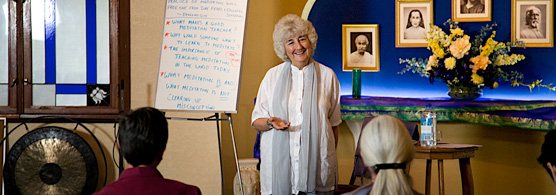
What is concentration? Concentration implies, first, an ability to release one’s thoughts and emotions from all other interests and involvements, and second, an ability to focus them on a single object or state of awareness. Concentration may assume various manifestations, from a dynamic outpouring of energy to perfectly quiescent perceptions.
On every level of mental activity, it is concentration that is the key to success. What is not generally known is that a concentrated mind succeeds not only because it can solve problems with greater dispatch, but also because problems have a way of somehow vanishing before its focused energies, without even requiring to be solved. A concentrated mind often attracts opportunities for success that, to less focused individuals, appear to come by sheer luck.
A person whose mind is concentrated receives inspirations in his work and in his thinking that, to duller minds, may often seem the proof of special divine favor. Yet such seeming “favors” are due simply to the power of concentration. Concentration awakens our powers and channels them, dissolving obstacles in our path, attracting opportunities, insights, and inspirations. In many ways concentration is the single most important key to success.
This is particularly true in yoga practice. The mind, in meditation especially, must be so perfectly still that not a ripple of thought enters it. God, the Subtlest Reality, cannot be perceived except in utter silence. Much of the teaching of yoga, therefore, centers on techniques designed specially for developing concentration.
By concentrating a person can temporarily become one with something external to himself, gaining thereby a far deeper understanding of it than would be possible by aloof scientific objectivity. But in concentration on our own higher realities, identification with them becomes lasting. For in this case there is no other, more personal, reality to come back to. We are the infinite light, and love, and joy, and wisdom of God. Even now, our concentration should be developed with these higher directions in mind.
Obviously, then, the most effective technique of concentration will be one which both interiorizes the mind, and permits a gradual transition from technical practice to utter stillness. The technique of watching the breath fulfills both of these requirements-better, perhaps, than any other possibly could.
Concentration on the breath, unlike other forms of concentration, leads naturally to meditation. Concentration on a project may bring about its completion, but that is not in itself an inducement to meditation. By concentration on the breath, however, the breath actually diminishes, until breathing is automatically and effortlessly suspended in breathlessness.
In the state of breathlessness, the senses themselves become automatically stilled, permitting an undisturbed continuation of the concentrated state. Once the mind is so perfectly focused, its concentrated power may be applied to any object one wishes.
Periods of breathlessness may come to you, while practicing… Don’t be alarmed; they can’t possibly hurt you, as long as you let the breath flow naturally, and don’t try to hold it in or out of the lungs by force. When your body needs to breathe again, it will do so. By increasingly deeper calmness, however, you will find that you need less and less fresh air to sustain your body.
Start a New Meditation Practice or Inspire Your Current One
The 10-week Ananda Course in Meditation online course is designed to provide in-depth instruction in scientific meditation techniques that bring more peace, deeper relaxation, and focused concentration to every area of your life, regardless of outer conditions.
These techniques are based on the teachings of Paramhansa Yogananda, author of Autobiography of a Yogi.
